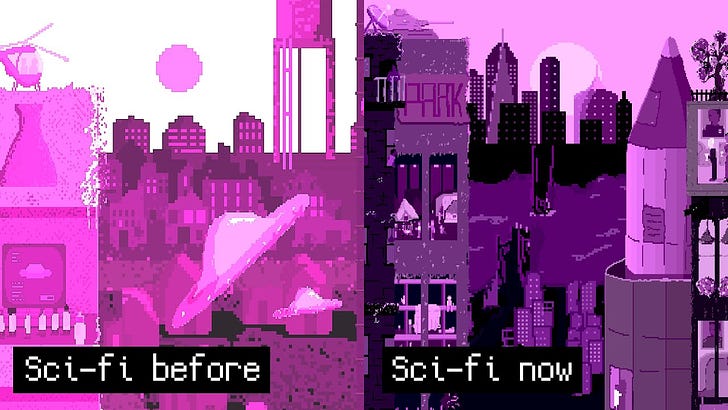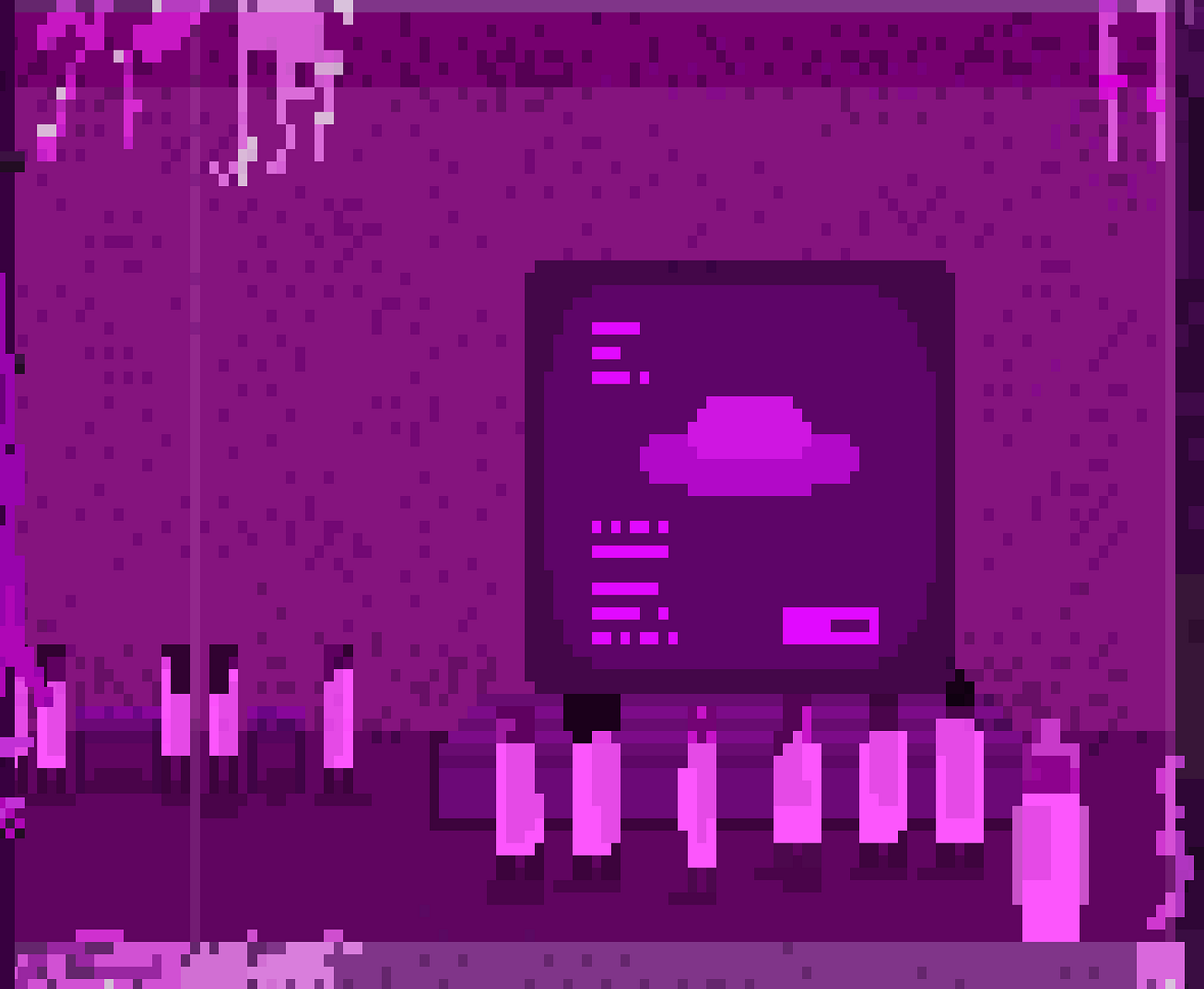Behind the scenes: Who killed the world?
Analyzing the last 70 years of sci-fi films and TV shows
This post is about how I made my latest piece in the Pudding – Who killed the world? The video version is above. You should read or watch it before reading this post. If you want to stay updates on my work, subscribe to this newsletter!
Inspiration
I love science fiction. I love when science fiction imagines rich worlds that feel just barely within reach for humanity. I love when sci-fi explores our deepest fears and our most pollyannaish hopes. We are mere specks in an unfathomably large universe. Yet in sci-fi, we can discover something that completely upends our understanding of the world.
So I was incredibly excited to delve into a data analysis of sci-fi. But it wasn’t just for the sake of focusing on sci-fi for three months. It was driven by two ideas that were stuck in my head.
One was this idea that films and TV shows are a way that societies explore their subconscious. My former Vox colleague Emily St. James introduced me to the idea. (Read her incredible piece here.) I’m fully bought in on this argument – and I think sci-fi as a genre makes this connection especially clear.
The other was the idea that cultures have a subconscious narrative arc. Americans tend to always assume things were better. Martin Luther King Jr. said: “The arc of the moral universe is long, but it bends toward justice” – something Barack Obama has cited multiple times. For Russians, author Fyodor Dostoevsky defined the term Russian Soul as “the most basic, most rudimentary spiritual need of the Russian people is the need for suffering, ever-present and unquenchable, everywhere and in everything.”
Now, the last few years of working with undergrads has made me wonder if this American optimism is eroding. When I was in college, I think there was still a sort of optimism – a hope – that even if things are terrible, that eventually we can make it better. In fact, I often found the Obama-era college vibe insufferably optimistic. But what I often see now is anxiety, fear, and paralysis over what may come – almost an assumption that things will get a lot worse before they get better.
So if sci-fi helps us explore our subconscious, I thought I might see that emerging pessimism in how sci-fi has changed over the past 70 years.
And that’s what I found.
Now, if you didn’t read or watch the piece, it’s not that modern sci-fi has narrative arcs where things don’t work out. Rather, it’s that sci-fi introduces a world where something has already gone terribly wrong, and the story is about making that dystopia better. If we put ourselves in that world, it means that we don’t solve our current crises; it means the things we’re worried about actually happen, and only then can we rebuild. I see this reflected in the political attitudes of a lot of 20-somethings – this feeling that everything has to burn down in order for a rebirth.

Modern sci-fi films often start after the world has completely broken. But we live in a world where we’re trying to avoid that fate.
Ultimately I argue that we need sci-fi to help us imagine a future that we want to inhabit. It’s not a novel argument; it’s just arguing the exact same thing sci-fi advocates said generations ago. But given where we are today, I think it’s especially urgent.
Drawing the new world
A huge part of executing this piece required me to draw three huge scenes to depict these sci-fi worlds. I knew it would be hard – but it was even harder than I even imagined.
Here’s my first sketch:
At this point, I had a concept I really liked – but I didn’t know what contents these illustrated worlds would have. I was subconsciously putting off the hardest part.
So I sat down and started to sketch out how I imagined these worlds. Notably it was only moderately hard to conceptualize the world that represented today’s pessimistic sci-fi – after all, I’ve seen so many of those films and TV shows. It was slightly harder conceptualizing the 1950s world, but that just required some historical research to get an idea of what needed to be in the scene. The incredibly difficult part was conceptualizing the sci-fi stories that I hope will exist in the world – the optimistic future version.
It’s horrifying to reveal the kind of things I want in the future. I don’t have any hot takes on what I want for the future, but to articulate those in pictures made me feel quite vulnerable. It’s also really hard to figure out how it will all fit together in one scene!
The concept required these scenes to be vertical, which meant that tall buildings were necessary. That isn’t necessarily what I want for our future, but it did force me to figure out how I can visualize what I want while still making it a vertical experience.
Because I wanted to create a parallax effect, I ended up having to make sketches like this to get my head around the scene:
And eventually I got to drawing.
Now, usually when I make pixel art, I use Aseprite. But the idea of drawing hundreds of thousands of pixels with my mouse seemed terrible. So I switched to an iPad app called Pixaki. It was a great decision. Pixaki is similar to Procreate, the gold standard for iPad drawing apps. It’s not quite as feature-filled, but still highly recommended and well worth the money.
Once I put stylus to iPad, my imagination came alive – and I started to weave micro-stories into each scene.
For example, in the 1950s scene, there are a bunch of scientists looking at massive CRT screens attached to giant sensors pointed at aliens.
There are also normal people doing normal people things, caught in their own minds and oblivious of what’s happening around them.
In the modern-day scene, there is an authoritarian military leader whose portrait hangs inside various rooms. Here’s one of them, but there are many more:
And in the future setting, I loved coming up with future interfaces.
There are so many little microstories in these illustrations that I probably forgot some of them existed.
The data and LLMs
One notable thing here is that I used the ChatGPT API to analyze the films. I was a bit nervous with this, so some folks at the Pudding recommended I use Claude or some other large-language models (LLMs) to test whether they returned similar results.
I tried a prompt, manually assessed a sampling of the results, and tweaked the prompts until they came back with what I thought was an accurate analysis. Notably, a lot of the questions are subjective, so that’s why this manual portion was important.
For a while, I was trying to find a systematic way to resolve the differences between the ChatGPT and Claude results. But then I realized ChatGPT was far better at this particular task, so I stuck with GPT’s answers. (I’m not saying ChatGPT is better than Claude! I’m only saying that, for this particular task and the prompts I was providing, ChatGPT returned results I thought were more accurate.)
I’m still trying to figure out a good process for working with LLMs. It’s not quite perfect, but there is a lot of potential. I’ve worked with similar data that uses human analysis, and it was filled with errors; how could it not be? I’ve also written Python scripts to do content analysis, but those were also quite imperfect. Ultimately I think this was the best way to get the most accurate results, but I’m excited to develop more robust practices around LLMs in journalism.
On imagining the future
We are all shaped by the stories we heard growing up, and the story I often heard about my family was their escape from North Korea during the Korean War. The way they told it to me was that, one day, they had to pack what they could carry, leave behind the only home they knew, and march southward. My grandfather was often afraid that the North Koreans would find him. When I visited my great aunt in her Kansas nursing home, she said to me: “Wouldn’t it be great if I could go back home? You should go back; we have a house in Pyongyang.” I grew up assuming societal collapse and the subsequent suffering was not only possible, but imminent. Because that story I heard growing up was about everything falling apart.
I would prefer to avoid that fate, and I believe it’s possible.
I’ve heard the joking way people say “burn it all down,” and I think that sentiment has taken root in a lot of our politics. I understand; a clean slate feels so much better than trying to fix our current one. But I don’t think they’ve seen what kind of suffering that brings.
Imagining the future we want is hard. It’s not just a creative pursuit; it’s a problem-solving exercise that is requires us to be empathetic, humble, and resilient. Parts of it might be joyful, but most of it is working our way through compromises, dead ends, and gridlock. Ultimately it requires us to understand that the stories we were told growing up are not the product of a predetermined arc. Rather, they were imagined, then made real, by humans.












Loved the analysis and the storytelling! There might be a Hollywood bias in this though. Of course the majority of sci-fi is produced there, so it's a reasonable bias. Would be curious to group by cultures/continents and not just eras.
Would you ever consider sharing some of the prompts that you tried and/or found success with for assessing certain attributes of the films? I'd be curious to see the evolution!